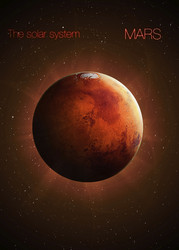Trending science: High clouds over Mars - what do they tell us?
It’s not just here on Earth that overcast weather occurs – spacecraft and ground-based telescopes have spotted numerous clouds of ice crystals hovering over Mars. Two particularly unusual plumes, which occurred in March and April 2012, have caught the attention of scientists, and may reveal secrets about the state of the Martian atmosphere. They are the subject of a new study recently published in Nature and led by astronomer Agustín Sánchez-Lavega of the University of the Basque Country in Bilbao, Spain. The study focuses on two bright, extremely high-altitude plumes at the Martian terminator (the day–night boundary) which were spotted by intrigued amateur astronomers in spring 2012. The clouds were estimated to be located 200 to 250 kilometres or more above Mars’s surface. Extending about 500 to 1 000 kilometres in both the north–south and east–west directions, they lasted for about 10 days, changing their structure from day to day. According to Nature, the plumes' sheer height is what is difficult to explain. In order to try to discover its significance, Sánchez-Lavega’s team coordinated observations from amateur astronomers, and searched imagery from Mars spacecraft. They used photometric measurements to explore two possible scenarios and investigate their nature. One explanation is that the plumes were formed by shards of frozen carbon dioxide or water vapour. Another is that the plume was an aurora linked to a known region on the surface where there is a large anomaly in the crustal magnetic field. This aurora would be 1 000 times brighter than an aurora on Earth. There are no easy answers, however, and the research team emphasises in the abstract that both of the proposed explanations defy our current understanding of Mars’ upper atmosphere. The team are still working to resolve the mystery, and they may have some help from NASA and the European Space Agency (ESA) in the coming years. The ESA notes that further insights should be possible following the arrival of ESA’s ExoMars Trace Gas Orbiter at the Red Planet, scheduled for launch in 2016. Meanwhile, Nature suggests that NASA's MAVEN spacecraft which is currently orbiting Mars, would be able to see a plume if it happened to be looking ‘at the right place at the right time’ – a situation which unfortunately has not yet occurred. For further information, please visit: http://www.nature.com/nature/journal/vaop/ncurrent/full/nature14162.html
Countries
Spain



